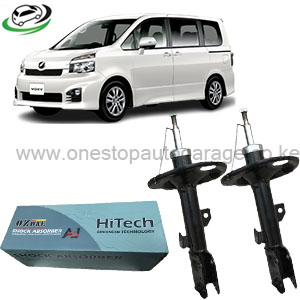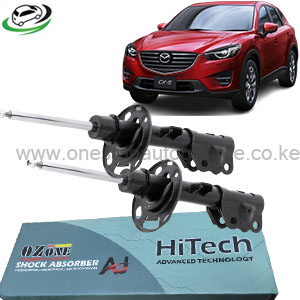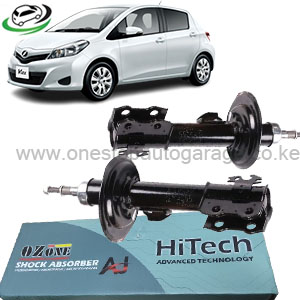-11%
Get Front Shock Absorber Toyota Vitz Corolla/Axio/Belta/Ractis 334472/334473 Ozone
Shock absorbers, also known as dampers, are critical components of a vehicle’s suspension system. They control the impact and rebound movement of the vehicle’s springs and suspension, ensuring a smooth and stable ride. Shock absorbers work by converting kinetic energy into thermal energy (heat), which is then dissipated through hydraulic fluid. This process helps to dampen the oscillations and maintain contact between the tires and the road, providing improved handling, comfort, and safety.
Functions of Shock Absorbers
Shock absorbers serve several vital functions in a vehicle’s suspension system:
- Damping Vibrations: They absorb and dampen the oscillations from the springs, preventing the vehicle from bouncing excessively after hitting a bump or pothole. This damping effect provides a smoother ride and enhances passenger comfort.
- Improving Stability and Handling: Shock absorbers help maintain tire contact with the road by controlling the up and down movement of the suspension. This improves the vehicle’s stability, handling, and braking performance.
- Reducing Wear and Tear: By controlling the motion of the suspension, shock absorbers reduce stress on other suspension components and the vehicle’s chassis. This helps to extend the lifespan of these parts and reduces maintenance costs.
- Enhancing Safety: Properly functioning shock absorbers ensure that the tires remain in contact with the road surface, providing better traction and control. This is crucial for safe braking, cornering, and overall vehicle handling.
Types of Shock Absorbers
There are several types of shock absorbers used in vehicles, each designed for specific applications and performance characteristics:
- Twin-Tube Shock Absorbers: The most common type, featuring an inner tube (where the piston moves) and an outer tube (which holds the hydraulic fluid). Twin-tube shock absorbers are generally used in standard passenger vehicles.
- Monotube Shock Absorbers: These have a single tube with a floating piston inside to separate the hydraulic fluid from the gas. Monotube shocks offer better heat dissipation and are often used in performance and off-road vehicles.
- Gas-Charged Shock Absorbers: Similar to twin-tube shocks but with a chamber of pressurized gas (usually nitrogen) to reduce aeration and improve performance. They provide better response and are commonly used in modern vehicles.
- Adjustable Shock Absorbers: These allow the driver to adjust the damping characteristics to suit different driving conditions or preferences. They are often found in performance and racing applications.
Signs of Worn or Failing Shock Absorbers
Shock absorbers can wear out over time due to constant use and exposure to harsh driving conditions. Recognizing the signs of worn or failing shock absorbers is essential for maintaining vehicle safety and performance:
- Excessive Bouncing: If the vehicle continues to bounce after hitting a bump, it indicates that the shock absorbers are no longer effectively damping the oscillations.
- Poor Handling and Stability: Worn shock absorbers can lead to poor handling, increased body roll, and instability, especially when cornering or braking.
- Uneven Tire Wear: Shock absorbers that are not functioning correctly can cause uneven tire wear due to improper contact with the road.
- Leaking Fluid: Visible signs of hydraulic fluid leaking from the shock absorbers indicate that the seals are worn, and the shocks need to be replaced.
- Nose Diving and Squatting: Excessive nose diving when braking or squatting when accelerating are signs of worn shock absorbers.
- Knocking or Rattling Noises: Unusual noises coming from the suspension area can indicate loose or worn shock absorbers.
Maintenance and Replacement
Maintaining and replacing shock absorbers is crucial for ensuring vehicle safety and ride quality. Here’s a guide to their maintenance:
- Regular Inspection: Periodically inspect the shock absorbers for signs of wear, leaks, or damage. Pay attention to any changes in the vehicle’s handling or ride quality.
- Timely Replacement: Shock absorbers typically need replacement every 50,000 to 100,000 miles, depending on driving conditions and vehicle type. Refer to the manufacturer’s recommendations for specific intervals.
- Quality Components: Use high-quality replacement shock absorbers that match the vehicle’s specifications. Investing in quality parts ensures better performance and longevity.
- Professional Installation: If you are not experienced with suspension systems, have a professional mechanic install the new shock absorbers. Proper installation is crucial for optimal performance and safety.
Replacement Process
Replacing shock absorbers involves several steps:
- Lift and Secure the Vehicle: Use a jack to lift the vehicle and support it with jack stands. Remove the wheels to access the shock absorbers.
- Remove the Old Shock Absorbers: Unbolt the shock absorbers from the suspension and chassis. Carefully remove them, noting the orientation and mounting points.
- Install the New Shock Absorbers: Position the new shock absorbers and bolt them in place, ensuring they are properly aligned and secured. Follow the manufacturer’s torque specifications for the bolts.
- Reassemble and Test: Reinstall the wheels, lower the vehicle, and perform a test drive to ensure the new shock absorbers are functioning correctly. Check for any unusual noises or handling issues.
Follow us on Facebook for more parts.



